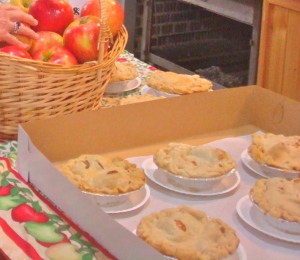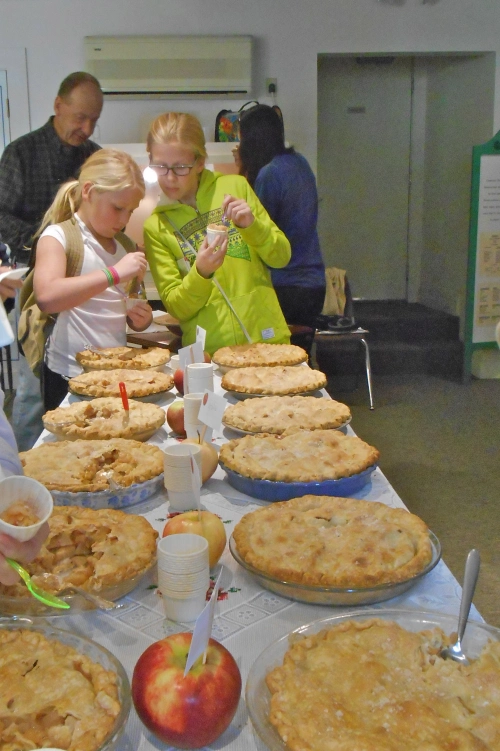
The apple pie evaluators took their job seriously at White Memorial Conservation Center, Litchfield, Connecticut. (Bar Lois Weeks photo)
AFTER TWO MONTHS of intensive research, we are forced to admit failure — once again — in our perennial quest to definitively answer a question that has plagued civilization since the discovery of the cooking fire: what is the best pie apple?
Our failure was not due to a lack of effort, and we had the help of prodigious pie-makers from across the region. We began by baking, inhaling, and serving more than 2,000 five-inch, single-serving apple pies at the Eastern States Exposition (“The Big E”) for 17 days in September, and tasted not a few of them.
We talked pies with Kim Harrison, one of a team of volunteers that made the pies to raise funds for The Preservation Society in Granby, Massachusetts. We spoke with dozens of customers about the merits of one variety over another.
The Big E pies have a flaky top crust covering a filling of several varieties lightly spiced. Many people topped off their pie with vanilla ice cream, a few with thin slices of cheddar. The apples were supplied by five Massachusetts orchards: Cold Spring Orchard in Belchertown, Clarkdale Fruit Farms in Deerfield, Nestrovich Fruit Farm in Granville, Pine Hill Orchards in Colrain, and Red Apple Farm in Phillipston.
Most of the pies included McIntosh, a perennial contender for the gold standard since its discovery on an Ontario farm more than two centuries ago. (McIntosh was introduced to New England in 1868 by Vermont’s Dr. Thomas H. Hoskins.)
Its flavor and aroma are so good that most people forgive McIntosh’s tendency to break down when baked, and add at least some to any varietal mix.
Akane, an early season apple developed in Japan in 1937 and introduced in the United States in 1970, was also noteworthy in this year’s pies for its lightly tangy flavor and texture.
In our informal survey of visitors, opinions about the best pie apple ran the gamut, from heirlooms like Baldwin (Wilmington, Massachusetts, 1740) to recent entries such as Pink Lady (Australia, 1989). Northern Spy (East Bloomfield, New York, in 1840, from seeds from Salisbury, Connecticut) has a particularly loyal fan base.
The closest we came to discovery, though, was the radiance of a woman purchasing 14 Gravenstein apples, an early season heirloom from Europe that dates back to at least the 1600s. The now hard-to-find Gravs were popular in New England until the bitterly cold winter of 1933-34, when many of the trees perished (along with more than one million Baldwin trees). It has never recovered as a commercial apple, but can still be found at some orchards.
Pie preferences are often passed down from generation to generation. The woman purchasing 14 Gravensteins put six in her bag at first, and as we talked she kept adding to her total until she got to 14. She planned to make two pies with them, just the way her mother did.
It was not the first time during our years at The Big E that the sight of Gravensteins has inspired such passion, and we suspect it will not be the last. I have not made a pie using just Gravenstein, but if it is as good baked as it is eaten fresh, the woman may be on to something. The apples were special, bursting with juice, with a lightly crisp, lemony tart flavor.
The flavor of nearly all of the varieties cited at The Big E, we noted, is more tart than sweet. That’s not to say that you can’t make a great pie using sweet apples, but a hint of tartness lends a pie complexity and zest.
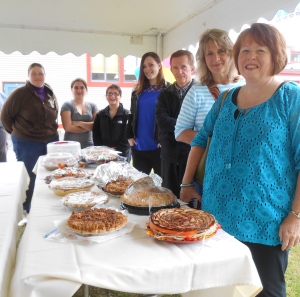
Bakers pose with their entries prior to judging at the 2014 Great New England Apple Pie Contest. (Bar Lois Weeks photo)
NEXT WE TRIED immersion, serving as judges in the 5th Annual Great New England Apple Pie Contest October 18 at Wachusett Mountain’s annual AppleFest in Princeton, Massachusetts. We dutifully sampled 30 pies in less than two hours, using the two-bite method: an introduction to the pie, and a second impression. It is the only way to do justice to this many pies.
There were some incredible-looking pies — entries are judged on appearance and presentation as well as flavor and texture — in two categories, Apple Only and Apple And Other. Several had latticed or elaborately sculpted crusts, including the winner of Apple Only, Theresa Matthews of Gardner, Massachusetts.
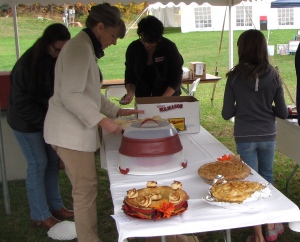
Theresa Matthews’ winning 2014 Great New England Apple Pie Contest pie is in the foreground. (Russell Steven Powell photo)
The judges, in addition to me, were Bar Lois Weeks, executive director of the New England Apple Association, for the third year; local businessman Burt Gendron, a veteran pie taster; Julia Grimaldi, representing the Massachusetts Department of Agricultural Resources; and radio personalities Chris Zito of WSRS and Ginny Sears of WTAG, both in Worcester.
We did not know the varieties used in any pie, although we were able to identify McIntosh flavor and texture in some, and make good guesses about Cortland, an 1898 cross of McIntosh with Ben David, similar in flavor to McIntosh but larger and firmer.
Most of the entries were good to very good, with several reaching exalted status. The few low-scoring pies suffered more from lackluster crusts than poor apple flavor.
One pie pairing pears with apples tasted mostly of apples — finding a balance that allows the milder pear flavor to come through can be tricky. But apples and pears is a proven combination, well worth the effort to get it right.
Green grapes and apples, on the other hand, may go well together fresh in a fruit salad, but made an undistinguished pie filling. While there are many flavorful ways to serve apples with bacon or peanut butter, the pies that combined them did justice to neither apple nor “other.”
Other ingredients in Apple and Other were caramel, cranberries, cream cheese, raisins, walnuts, and Jack Daniels. They all worked well with this versatile fruit.
Apples in a number of pies had been sliced by a mandolin slicer, and generally this did not improve the pie’s texture. The thin, uniform slices often stick together in a stack, which can lead to uneven cooking and consistency.
Theresa Matthews used only Cortland apples in her winning Apple Only pie. Both contest winners in 2012 also used just Cortland. Could this make Cortland the undisputed champ?
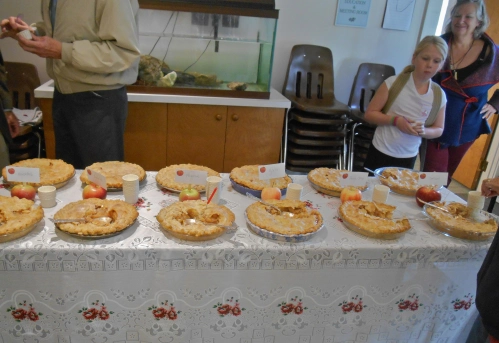
Chef Gerri Griswold, rear right, looks on as people sample her pies at White Memorial Conservation Center, Litchfield, Connecticut. (Bar Lois Weeks photo)
FROM THERE we conducted another experiment, at the White Memorial Conservation Center in Litchfield, Connecticut. Chef Gerri Griswold baked a dozen pies for our October 25 apple talk and tasting event, two each using single varieties: Cortland; Empire, a 1945 offspring of McIntosh, crossed with Red Delicious, released in 1966; Gala (New Zealand, 1934, 1970), Honeycrisp (Minnesota, 1961, released in 1991), Macoun, a 1909 cross of McIntosh with Jersey Black in New York, released in 1923); and McIntosh.
Gerri scrupulously followed the Joy of Cooking apple pie recipe for all 12 of her creations, using the same prepared Pillsbury crust. We sampled each pie several times, as did the 20 or so people of all ages in attendance. A sheet of paper nearby for our scores and comments went mostly untouched, as most people were content to savor the experience.
There was plenty of excellent pie, but no clear-cut winner. Cortland had the most support in an informal poll, but the Empire, Macoun, and McIntosh pies all had champions. The McIntosh pie had surprisingly firm texture, soft but not mushy, and holding together.
Gerri had tried a similar experiment during our first appearance at White Memorial two years ago, baking four pies using single varieties. On that day, Mutsu, a large yellow apple discovered in Japan in 1930 (also known as Crispin), was the favorite pie apple.
The pies made with the sweet Gala and Honeycrisp apples did not fare as well as the others. For most of us, they were a little too sweet and their flavor lacked character. Gerri acknowledged that were it not for the taste test she would have reduced the sugar in the pies made with these varieties.
WE CONTINUED our study this past Sunday, November 2, during Franklin County CiderDays. Sue Chadwick, who grows a wide range of rare heirloom apples at her Second Chance Farm in Greenfield, Massachusetts, kindly donated a pie for our research, one of just three left from the 20 she baked to sell at the event the day before.
Sue uses a mix of apples in her pies, and the varieties could be different every time. Even if she could tell exactly what went into each pie, it would be hard for most people to find the apples to replicate it. The pie she gave us had rich apple flavor, as good or better than any made with a single variety.
Having made such little progress, we are going back to view Andrea Darrow’s three-part video series about apple pie-making, below. Andrea, of Green Mountain Orchards in Putney, Vermont, bakes hundreds of apple pies every fall, peeling every apple by hand. She uses several varieties, including Cortland and McIntosh, and piles them high.
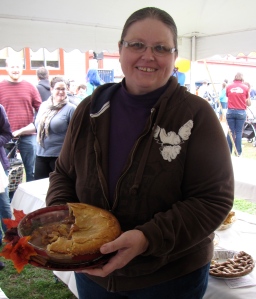
Theresa Matthews with all that was left of her winning 2014 Great New England Apple Pie Contest pie after the judging. The Apple Rose Tarts on top were long gone. (Russell Steven Powell photo)
THERESA MATTHEWS has been working on her apple pies since she was a teenager. “My Mum was the reason behind that. She never measured for her pie crusts and I could never, ever get it right.”
Theresa’s preference for Cortland goes back at least a generation. “I’ve tried other apples, but I always go back to Cortland. I got that from my Mum as well.”
She did get it right. Here is the recipe for Theresa Matthews’ first-place pie.
Mum’s Apple Pie
Crust
3 c all purpose flour
1 t sea salt
1 T granulated sugar
1-½ sticks unsalted butter (cold)
⅓ c shortening (cold)
½ c ice cold water
one egg white
In a food processor bowl place flour, salt, sugar, butter, and shortening. Cover and pulse until blended about the size of peas. While running the processor, pour cold water in a steady stream until pastry ball forms. Divide into two balls, chilling for at least 30 minutes.
Roll out one crust on lightly floured parchment paper 1” larger than pie tin. Carefully transfer pastry to pie tin, and try not to stretch to avoid shrinking. Take egg white and brush onto entire bottom crust and refrigerate for 15 minutes or until filling is set.
Filling
6 thinly sliced Cortland apples
½ c unsalted butter
3 T all purpose flour
¼ c water
½ c granulated sugar
½ c packed light brown sugar
1½ t cinnamon
½ t nutmeg
Preheat oven to 350°.
Melt butter in a saucepan. Stir in flour to form a smooth paste. Add in water, sugars, and spices and bring to a boil. Reduce temperature to a simmer. In a large mixing bowl place sliced apples. Pour sauce over apple slices and mix carefully to keep apple slices whole.
Carefully spoon coated apple slices into bottom crust, mounding slightly. Take care not to pour too much liquid to run out, reserving 2 T sauce. Brush bottom crust edge with egg whites and cover mounded apples with top crust, trim and press to seal. Cut slits for steam to release during cooking and brush glaze onto top of pie.
Cut pie dough scraps into the shapes of leaves and arrange them on the pie where the rose tarts will be placed. Brush glaze over leaves. Save remaining pie dough for Apple Rose Tarts (recipe below).
Place in preheated oven and lay a sheet of aluminum foil over pie to prevent burning. Bake 60-75 minutes or until deep golden brown. Cool. Serve as is or with ice cream. Makes one 9” pie.
Apple Rose Tarts
Preheat oven to 350°.
Inspiration from diy-enthusiasts.com/food-fun/easy-apple-desserts-apple-roses/
2 Cortland apples sliced thinly
3 c water with 1 c sugar dissolved to make a simple syrup
1 T lemon juice (to help prevent browning)
Cinnamon sugar
Pie crust dough (left over from Mum’s Apple Pie, above)
Add apple slices to a pan of sweet syrup, making sure to cover all apples. Cook over medium-low heat until apples are pliable.
Roll out remaining pie dough in a rectangle about 8 to 10 inches wide and 10-12 inches long. Cut 8-10 one-inch wide strips along dough’s length.
Dry off 6 apple slices on a paper towel before arranging on a strip of pie dough. Lay out Overlap slices on strips so when rolled they will form the apple rose petals. Take care to leave about 1/2” of dough to seal the tart once rolled. Sprinkle with cinnamon sugar before rolling up tart into a rose. (Photo references available on aforementioned website)
Place tarts on parchment paper about 2 inches apart and bake for 25 minutes or until brown and bubbly. Once tarts are cool, remove from parchment and using toothpicks insert into place on baked and cooled apple pie.
* * *
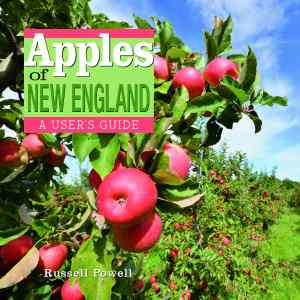 APPLES OF NEW ENGLAND (Countryman Press, 2014), a history of apple growing in New England, includes photographs and descriptions of more than 200 apple varieties discovered, grown, or sold in the region. Separate chapters feature the “fathers” of American wild apple, Massachusetts natives John Chapman (“Johnny Appleseed”) and Henry David Thorea; the contemporary orchard of the early 21st century; and rare apples, many of them photographed from the preservation orchard at Tower Hill Botanic Garden in Boylston, Massachusetts.
APPLES OF NEW ENGLAND (Countryman Press, 2014), a history of apple growing in New England, includes photographs and descriptions of more than 200 apple varieties discovered, grown, or sold in the region. Separate chapters feature the “fathers” of American wild apple, Massachusetts natives John Chapman (“Johnny Appleseed”) and Henry David Thorea; the contemporary orchard of the early 21st century; and rare apples, many of them photographed from the preservation orchard at Tower Hill Botanic Garden in Boylston, Massachusetts.
Author Russell Steven Powell is senior writer for the nonprofit New England Apple Association after serving as its executive director from 1998 to 2011. Photographer Bar Lois Weeks is the Association’s current executive director.
Available in bookstores everywhere.
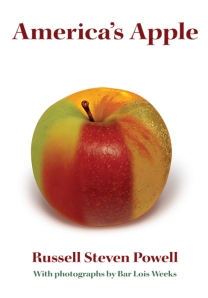 AMERICA’S APPLE, (Brook Hollow Press, 2012) Powell’s and Weeks’s first book, provides an in-depth look at how apples are grown, eaten, and marketed in America, with chapter on horticulture, John Chapman (aka Johnny Appleseed), heirloom apples, apples as food, apple drinks, food safety insects and disease, labor, current trends, and apple futures, with nearly 50 photographs from orchards around the country.
AMERICA’S APPLE, (Brook Hollow Press, 2012) Powell’s and Weeks’s first book, provides an in-depth look at how apples are grown, eaten, and marketed in America, with chapter on horticulture, John Chapman (aka Johnny Appleseed), heirloom apples, apples as food, apple drinks, food safety insects and disease, labor, current trends, and apple futures, with nearly 50 photographs from orchards around the country.
The hardcover version lists for $45.95 and includes a photographic index of 120 apple varieties cultivated in the United States. America’s Apple is also available in paperback, minus the photograph index, for $19.95, and as an ebook.
Available at numerous bookstores and orchards, and Silver Street Media, Amazon.com, Barnes and Noble, and other online sources. For quantity discounts, email newenglandapples@verizon.net.
* * *
